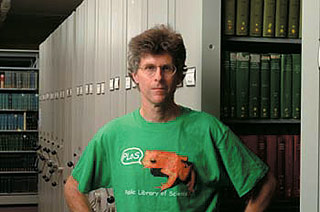Second Opinion
 |
|
Pat Brown |
|
A plan to make scientific publications freely available to all
By Pat Brown MD, PhDPhotograph by Stephen Gladfelter
Last year, Harold Varmus, Michael Eisen and I founded a nonprofit scientific publisher, the Public Library of Science (PLoS). In October 2003, PLoS (www.plos.org) began publishing its premier scientific journal, PLoS Biology. Everything PLoS publishes is immediately available online, free of charge, with no restrictions on access or use.
Here’s why: The public library, one of the greatest inventions of human civilization, has been waiting for the Internet. What seemed an impossible ideal in 1836, when Antonio Panizzi, librarian of the British Museum, wrote “I want a poor student to have the same means of indulging his learned curiosity, … of consulting the same authorities, … as the richest man in the kingdoms” is today within reach. With the Internet, we have the means to make humanity’s treasury of knowledge freely available to scientists, teachers, students and the public around the world. But it won’t happen automatically.
Our government spends more than $50 billion a year on non-classified research. What this investment yields are new scientific discoveries and ideas, recorded in scientific publications. The authors of these research reports, the scientists, give them away to publishers, receiving in return only an audience and the satisfaction of sharing their ideas and discoveries with the world. But if your mother learns she has breast cancer and desperately wants to find what researchers have discovered about her disease, or when your daughter in high school reads a story in the New York Times about the latest research on climate change and wants to see it with her own eyes, they face a perverse and unnecessary obstacle. They, and countless others around the world who would benefit from timely access to scientific and medical knowledge, cannot freely access the published results of research financed by their own tax dollars. An ever-growing online treasury of scientific and medical knowledge is open only to the fortunate few who have access to a major university library, or who are able to pay the exorbitant access fees charged by publishers.
Even at Stanford, the restrictions on access prevent us from being able to search the entire corpus of scientific articles for particular terms, concepts, methods, data or images and retrieve the results — you can’t “Google” the millions of scientific articles that have been published online!
Open access for scientific publishing
The traditional business model for scientific publishing, in which individuals or institutions pay publishers for access to research articles, is a vestige of an era when printing articles in paper journals and transporting them in trucks and boats was the most efficient way to disseminate new scientific discoveries and ideas. When each copy cost money to print and ship, it made sense to pass these costs on to the recipients. But today, the Internet delivers articles much more efficiently and conveniently, transforming the economics of scientific publishing. The costs of the remaining essential functions of scientific publishers — orchestrating peer review and professional editing — don’t scale with the number of copies distributed, but with the number of articles reviewed and published. But the benefits — to the authors, the scientific community and the public — grow with the number of potential readers who can access the published work. Charging for access is therefore no longer economically necessary, rational or fair — it needlessly limits access to an essential public good.
What’s the alternative? Just as midwives can earn a living without claiming ownership or control of the babies they deliver, publishers can and should be paid a fair price by the sponsors of the research, a “midwife’s fee,” for their role in orchestrating peer-review, editing and disseminating the results. But they should not be given the baby, OUR baby, to own and control. By paying publishers for each article at the time of its publication, instead of letting them own the article and charge for access, the doors to the online library could be opened to everyone.
An “open access” system for scientific publishing will not entail new expenses, nor should it place a financial burden on the authors. The governmental and private institutions that finance the research already pay most of the costs of this publishing indirectly — through the funds they provide to research libraries. These same institutions would accomplish far more with the same money by phasing out subscription payments to restricted-access journals and, instead, paying for open-access publication of the research they support.
An impressive and rapidly growing list of scientific organizations now advocate open-access publication. Yet, despite widespread support from scientists and the public, institutional inertia and fear of change delay its progress. We who benefit from access to great research libraries and generous public support of our research should remember Benjamin Franklin’s words: “As we enjoy great advantages from the inventions of others, we should be glad of an opportunity to serve others by any invention of ours; and this we should do freely and generously.” SM
Patrick O. Brown, MD, PhD, co-founder of the Public Library of
Science, is a Stanford biochemistry professor and a Howard Hughes Medical
Institute investigator.
Comments? Contact Stanford Medicine at

